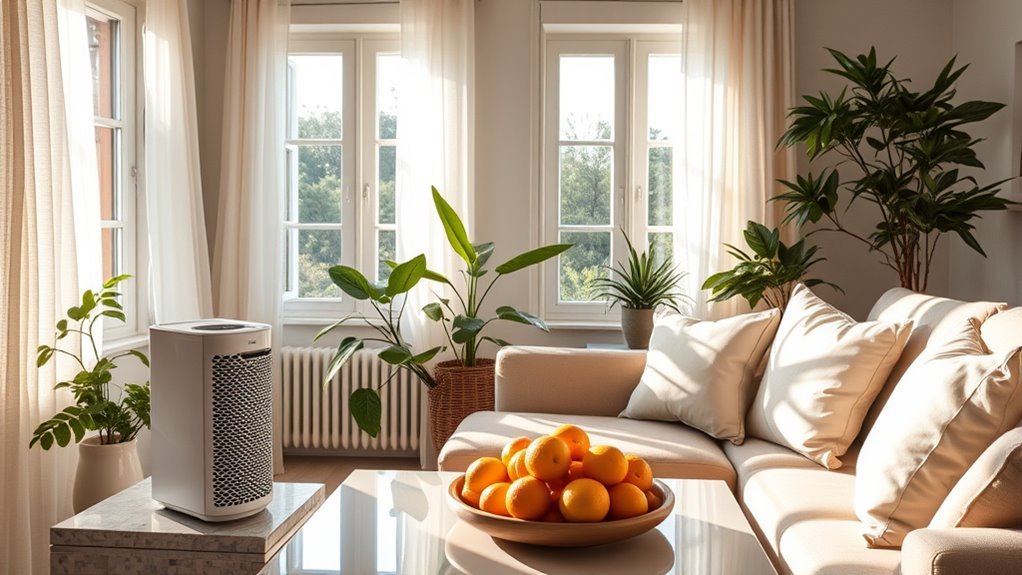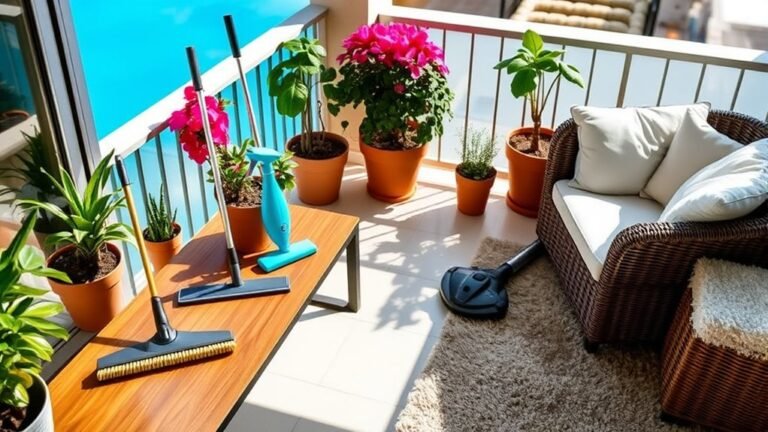How to Keep Your Home Germ-Free During Flu Season
To keep your home germ-free during flu season, regularly clean high-touch surfaces like doorknobs and countertops, and wash bedding and towels often. Use disinfectants properly, following instructions for contact time, and opt for hand sanitizers with at least 60% alcohol if soap isn’t handy. Practice good personal hygiene by washing hands thoroughly and showering daily. Improve air quality by opening windows and using HEPA-filter air purifiers. For more ways to safeguard your home, explore these simple strategies further.
Essential Cleaning Practices to Reduce Germs

Although it might seem obvious, regularly cleaning high-touch surfaces like doorknobs, light switches, and countertops is essential to cutting down germs in your home. You should set a cleaning frequency that fits your lifestyle—daily for busy areas and every few days for less-used spots. This routine helps prevent germs from building up and spreading. Don’t forget laundry precautions, either. Wash clothes, towels, and bedding often, especially during flu season, using the warmest water safe for the fabric. Handling laundry carefully by avoiding overcrowded machines and promptly drying items also reduces germ persistence. By sticking to these cleaning habits, you maintain a healthier space without feeling tied down, letting you enjoy your home freely while keeping germs at bay.
Effective Use of Disinfectants and Sanitizers
When you want to keep your home truly germ-free during flu season, knowing how to use disinfectants and sanitizers effectively is key. Understanding disinfectant types helps you choose the right one for each surface, maximizing sanitizer effectiveness without overuse. Here’s how to protect your space while maintaining freedom from worry:
Keeping your home germ-free starts with using the right disinfectants and sanitizers effectively during flu season.
- Match disinfectant types to surfaces—use sprays on counters, wipes on doorknobs—to kill germs efficiently.
- Follow contact time instructions; letting the product sit guarantees it destroys viruses and bacteria fully.
- Use hand sanitizers with at least 60% alcohol for quick, reliable germ control when soap and water aren’t available.
Tips for Maintaining Personal Hygiene at Home

Since germs can easily spread through everyday activities, maintaining personal hygiene at home is essential to keep you and your family healthy during flu season. Start by mastering proper handwashing techniques—scrub with soap and water for at least 20 seconds, especially after coughing, sneezing, or touching shared items. This simple habit dramatically reduces germ transmission. Personal grooming also plays a vital role; keep nails trimmed and clean to avoid harboring bacteria. Shower regularly and change clothes daily to minimize the buildup of germs on your skin and fabrics. Encourage everyone in your household to follow these routines consistently. By taking control of your personal hygiene, you’re not just protecting yourself—you’re creating a safer, freer environment where illness doesn’t stand a chance.
Managing Shared Spaces and High-Touch Surfaces
Keeping up with your personal hygiene sets a strong foundation, but germs can still linger on surfaces you share every day. Managing shared spaces and high-touch surfaces calls for a sense of shared responsibility—everyone doing their part keeps your home safer and gives you freedom from worry. Establishing simple communal routines makes this easier and more effective. Here are three key steps to help you take control:
- Regularly disinfect doorknobs, light switches, and remote controls—these hotspots are germ magnets.
- Set reminders for everyone to clean shared areas like the kitchen counter and bathroom sink daily.
- Encourage using personal towels and wiping down surfaces immediately after use.
Strategies for Ventilation and Air Quality Improvement

Although you might focus on cleaning surfaces, poor air quality can still let germs circulate in your home. To truly free your space from flu viruses, prioritize ventilation. Open windows regularly to invite natural ventilation; fresh air dilutes airborne germs and reduces their presence indoors. When weather or outside pollution makes opening windows tough, air purifiers become your best ally. Choose models with HEPA filters to trap viruses and bacteria effectively. Position air purifiers in high-traffic rooms to maximize their impact. Remember, improving airflow isn’t just about comfort—it’s about creating an environment where germs struggle to survive. By combining natural ventilation with air purifiers, you empower yourself to maintain a healthier home, giving you the freedom to breathe easier during flu season.
Frequently Asked Questions
Can Certain Houseplants Help Reduce Airborne Germs During Flu Season?
You might be surprised to learn that certain houseplants can boost indoor air quality, which indirectly helps reduce airborne germs. While they don’t eliminate viruses completely, their natural houseplant benefits include filtering toxins and adding moisture to the air. If you want a fresher, healthier space, picking a few easy-care plants could be your ticket. It’s a simple, free way to make your home feel cleaner and more inviting.
How Often Should I Wash Bed Linens to Prevent Flu Virus Spread?
You should stick to a bed linen frequency of washing at least once a week to keep germs at bay. If someone’s sick, bump it up to every two to three days. Use hot water and a good detergent—those washing techniques help kill viruses more effectively. Don’t worry, staying consistent doesn’t tie you down; it gives you the freedom to enjoy a fresher, healthier space without the flu bug hanging around.
Are Air Purifiers Effective Against Flu Viruses in the Home?
Just like folks once trusted a trusty quill, you can rely on air purifiers to help reduce flu viruses at home, but their effectiveness depends on air purifier types and filter efficiency. HEPA filters are your best bet—they trap tiny particles, including viruses. However, no purifier guarantees complete protection, so keep your space ventilated and combine purifiers with good hygiene. This way, you’ll keep your freedom to breathe easy indoors.
Can Pets Carry and Transmit Flu Germs to Family Members?
Yes, pets can carry and transmit flu germs to family members, so paying attention to pet hygiene is key. While they might not get sick like humans do, viruses can hitch a ride on their fur or paws, leading to virus transmission. You don’t have to limit your freedom with your furry friends, but regular grooming and hand-washing after petting them will help keep everyone safer and healthier.
What Role Does Humidity Play in Controlling Flu Virus Survival Indoors?
Did you know flu viruses survive up to 70% longer in low humidity? Keeping your home’s humidity levels between 40-60% can greatly reduce virus transmission. When the air’s too dry, flu viruses linger on surfaces and in the air, making it easier for germs to spread. By balancing humidity, you’re not just protecting your space—you’re taking control of your environment, helping you stay healthier and freer from illness.






